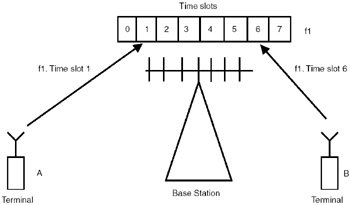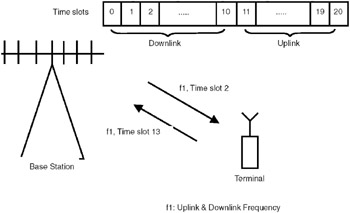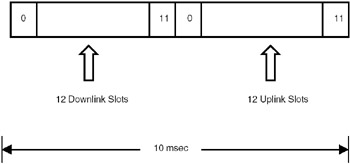8.3 TIME DIVISION MULTIPLE ACCESS
|
| < Day Day Up > |
|
8.3 TIME DIVISION MULTIPLE ACCESS
In time division multiple access (TDMA), one frequency is shared by a number of terminals. Each station is given a time slot in which it can transmit. The number of time slots is fixed, and the terminals transmit in the time slots allocated to them. For example, in mobile communication systems, each frequency is divided into eight time slots and hence eight mobile terminals use the same frequency, communicating in different time slots.
Figure 8.3 illustrates the concept of TDMA. Terminal A transmits in time slot 1 using frequency f1. Terminal B also transmits using frequency f1 but in a different time slot. Which terminal gets which time slot is decided by the base station.

Figure 8.3: Time division multiple access.
In TDMA systems, the time slots can be fixed or dynamic. In fixed TDMA, each station is given a fixed time slot (say, time slot 1 for station A, time slot 2 for station B, and so on). This results in a simple system design, but the disadvantage is that if a station has no data to transmit, that time slot is wasted. In dynamic TDMA, a station is assigned a time slot only when it makes a request for it. This leads to a more complex system, but the channel is used effectively.
An important issue in TDMA systems is synchronization: each station should know precisely when it can start transmission in its time slot. It is easy to tell terminal A that it should transmit in time slot 1, but how does terminal A know when exactly time slot 1 starts? If it starts transmission slightly early, the data will collide with the data in time slot 0. If it starts transmission slightly late, the data will collide with the data in time slot 2. The complexity of TDMA lies in the synchronization. Synchronization is achieved by the central station sending a bit pattern (101010101… pattern), and all the stations use this bit pattern to synchronize their clocks.
In TDMA, a single frequency is shared by a number of terminals. Each terminal is assigned a small time slot during which it can transmit. The time slot assignment can be fixed, or the assignment can be dynamic—a slot is assigned only when a terminal has data to transmit.
| Note | Synchronization is a major problem in TDMA systems. To ensure that each terminal transmits only during its time slot, very strict timings have to be followed. The central station sends a bit pattern to all the terminals with which all the terminals synchronize their clocks. |
| Note | In fixed TDMA, the time slots are assigned to each terminal permanently. This results in a simple implementation, but time slots are wasted if the terminal has no data to transmit. On the other hand, in dynamic TDMA, time slots are assigned by a central station based on the request of a terminal. Hence, a separate signaling slot is required to transmit requests for slots. In mobile communication systems, dynamic TDMA is used. |
8.3.1 Time Division Multiple Access–Frequency Division Duplex (TDMA-FDD)
As mentioned earlier, in radio systems, a pair of frequencies are used for communication between two stations—one uplink frequency and one downlink frequency. We can use TDMA in both directions. Alternatively, the base station can multiplex the data in TDM mode and broadcast the data to all the terminals; the terminals can use TDMA for communication with the base station. When two frequencies are used for achieving full-duplex communication along with TDMA, the multiple access is referred to as TDMA-FDD.
TDMA-FDD is illustrated in Figure 8.4. The uplink frequency is f1, and the downlink frequency is f2. Terminal-to-base station communication is achieved in time slot 4 using f1. Base station-to-terminal communication is achieved in time slot 4 using f2.

Figure 8.4: TDMA-FDD.
In TDMA-FDD, two frequencies are used for communication between the base station and the terminals—one frequency for uplink and one frequency for downlink.
8.3.2 Time Division Multiple Access–Time Division Duplex (TDMA-TDD)
Instead of using two frequencies for full-duplex communication, it is possible to use a single frequency for communication in both directions between the base station and the terminal. When two-way communication is achieved using the single frequency but in different time slots, it is known as TDMA-TDD.
As shown in Figure 8.5, the time slots are divided into two portions. The time slots in the first portion are for communication from the base station to the terminals (downlink), and the time slots in the second portion are for communication from the terminals to the base station (uplink). The base station will transmit the data in time slot 2 using frequency f1. The terminal will receive the data and then switch over to transmit mode and transmit its data in time slot 13 using frequency f1.

Figure 8.5: TDMA-TDD.
The advantage of TDMA-TDD is that a single frequency can be used for communication in both directions. However, it requires complex electronic circuitry because the terminals and the base station have to switch to transmit and receive modes very quickly. For illustration of the timings, the TDMA-TDD scheme used in digital enhanced cordless telecommunications (DECT) system is shown in Figure 8.6. Here the TDMA frame is of 10 milliseconds duration, which is divided into 24 time slots—12 for downlink and 12 for uplink.

Figure 8.6: TDMA-TDD in DECT.
In TDMA-FDD, two frequencies are used for communication between the base station and the terminals—one frequency for uplink and one frequency for downlink.
|
| < Day Day Up > |
|
EAN: 2147483647
Pages: 313